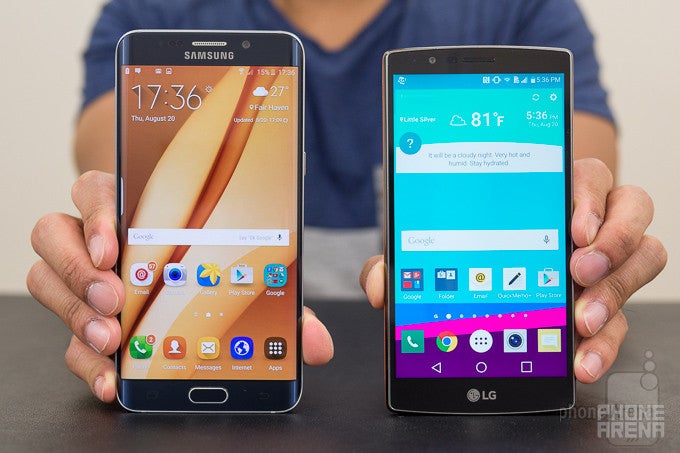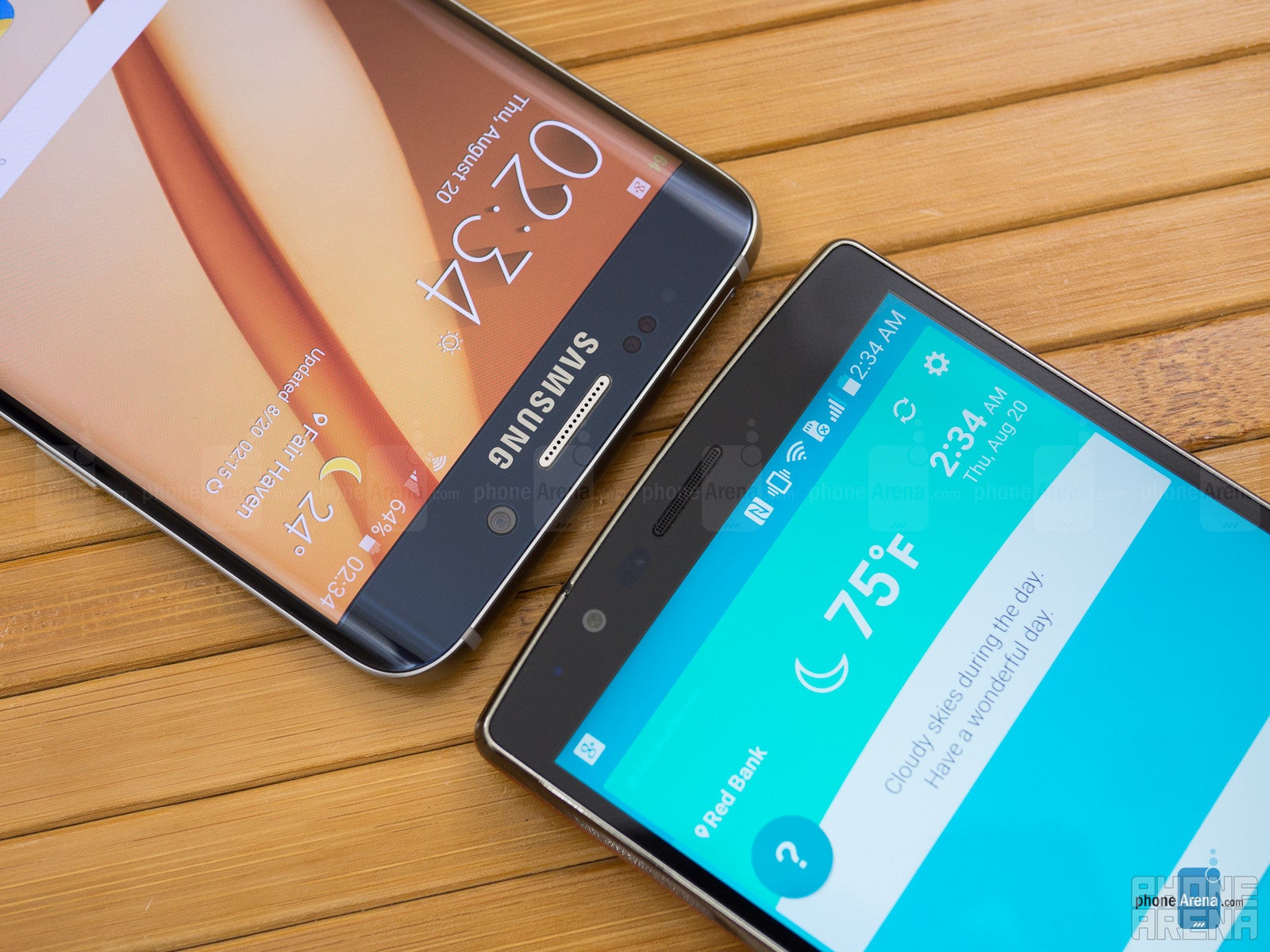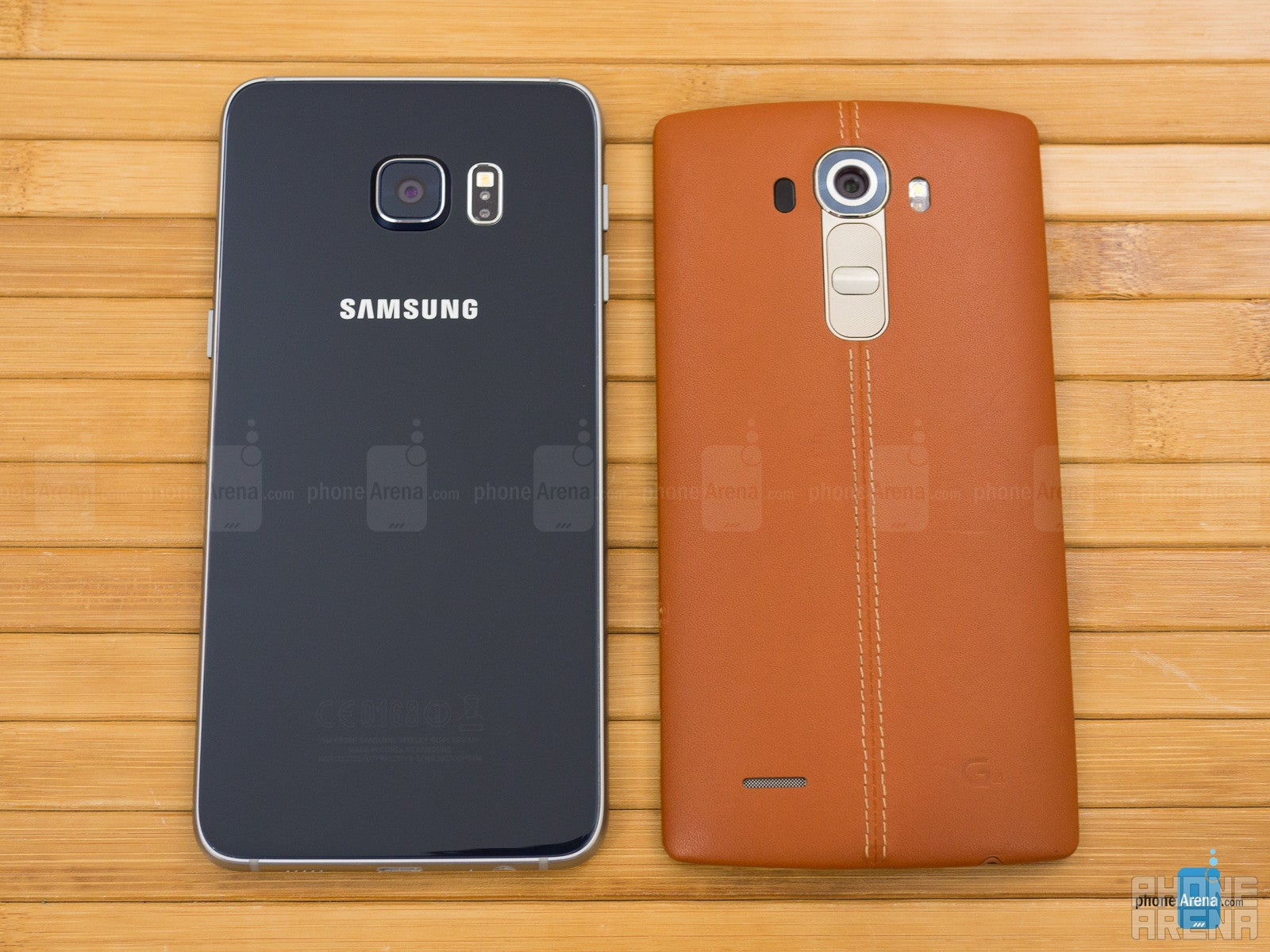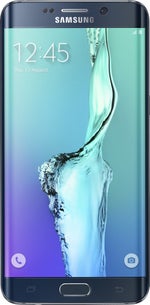Samsung Galaxy S6 edge+ vs LG G4

Introduction
So, have your sights set on the Samsung Galaxy S6 edge+? No wonder, this is one of the most exciting big-screen smartphones to hit the market recently! But it has to be considered that the phablet's outstanding design and impressive hardware power come at a price that may be too steep for some. Luckily, price-conscious buyers have a choice for a high-end smartphone that won't twist their pockets — we're speaking of the LG G4. By refusing to follow the prevailing design trends and utilizing carefully chosen hardware components, LG made a stand-out device whose imperfections are easily offset by its sub-$500 unlocked price, an affordable price tag by flagship smartphone standards. So, let's have a look at how LG's hero device compares with Samsung's latest and greatest!
Design
Metal and glass sheen versus plastic and leather practicality.
The Galaxy S6 edge+, even if it's merely an oversized S6 edge, makes for quite the show with its futuristic dual-edge curved screen and impressive metal and glass build. The LG G4 is on a different side of the spectrum of attractive, because it's appearance is comparatively modest, yet unquestionably classy with its genuine leather back. Without it, the LG G4 looks like a well put together, all-plastic smartphone, which makes for a pleasing sight, but certainly doesn't exude the same premium feel. There's a practical advantage to the latter's utilitarian design, however. The Galaxy S6 edge+'s glass back is a fingerprint magnet that could easily crack upon an unfortunate impact with the pavement, while the LG G4 is pretty much immune against both problems.
Nearly everything found on the S6 edge is present in the S6 edge+, including the handy fingerprint sensor, the heart rate sensor, the rapid charging microUSB 2.0 port, and built-in wireless charging. The LG G4 is mostly devoid of these niceties, save for the rapid charging port and the optional wireless charging cover. What the LG G4 has, which the S6 edge+ doesn't, is the ability to swap its empty battery for a fresh one, or expand its built-in storage with a microSD card. Another interesting bullet point in the LG G4's design is the unusual positioning of its volume and power keys on the device's back panel. It's unusual, but it works, until you try setting the volume with the keys while the phone is laying on its back, and you go "eh...".
At 5.86 x 3.00 x 0.39 inches (148.9 x 76.1 x 9.8 mm), the LG G4 is smaller than the Galaxy S6 edge+, which measures 6.08 x 2.98 x 0.27 inches (154.4 x 75.8 x 6.9 mm). However, Samsung's phablet has a slightly bigger display diagonal (it's 5.7 inches vs 5.5 inches for the LG G4), and is also much thinner, contributing to an unquestionably modern feel. The weight difference between the two, at 5.40 oz (153 g) for the Galaxy S6 edge+ and 5.47 oz (155 g) for the LG G4, is negligible. And as for which one's more comfortable to hold, it's really a question of which one feels better in your hand. We believe LG's handset has the advantage of smoother curves that are more natural to the palm, whereas the S6 edge+'s metallic lines feel slightly sharp in comparison. But the truth is that neither device is really designed for one-handed use.
Display
Both are excellent for multimedia, but Samsung's has a literal edge in color accuracy.
With its 5.7-inch, 1440 x 2560 resolution Super AMOLED display, the Samsung Galaxy S6 edge+ has a quite literal edge (or two) over the LG G4, which uses a 5.5-inch IPS LCD screen of the same exceedingly high resolution. Despite both screens being of Quad-HD resolution and high quality, there are stark differences between them in the way they reproduce those eye-popping visuals. Let's dig into the intricacies of our display measurement results.
Pixel density is great for both screens, coming in at 518 pixels per inch for the Galaxy S6 edge+ and 538ppi for the LG G4. Crispness aside, the S6 edge+ in 'Basic' screen mode has a color temperature of 6722 K, which is much closer to the reference 6500 K than the LG G4's 8031 K. 6500 K is the reference point where the mix of red and blue primary colors can be considered in balanced proportions. Temperatures above that result in perceived coldness of colors, while temperatures below are the opposite – warm. Thus, the LG G4 favors a colder color temperature, resulting in a dominant blue.
Next, let's have a look at the screens' minimum and maximum brightness levels. The former is useful to determine a display's readability in low-light conditions (darker displays put less strain on your eyes), while the latter makes or breaks a display's legibility in intense lighting. The Galaxy S6 edge+'s screen goes up to 502 nits of maximum brightness and down to just 1 nit, while the LG G4 goes up to 454 nits and down to 2 nits. These are both very good results, although the S6 edge+, obviously, is the brighter one.
Next, we'll discuss gamma value. The gamma curve is used to determine how accurately a display is able to reproduce images, in terms of shades, starting from the darkest and finishing with the brightest shades. Looking at the LG G4's measurements, its gamma value of 2.24 is actually pretty close to the 2.2 reference, which means color intensities are mostly evenly reproduced and there's no artificial contrast boosts or cuts to be aware of. With a slightly lesser value of 2.12, Samsung made the Galaxy S6 edge+'s lighter shades of gray a tad brighter than they would appear in reality, resulting in a deliberate contrast boost. Samsung likes to do that with recent Galaxy S displays, letting users enjoy colors a bit punchier than normal.
Where color balance is concerned, the S6 edge+ does present the primary colors in more correct proportions than its competitor, which is prone to exhibiting a blue-green color tint. This is due to an under-representation of red, caused by the colder color temperature. The brighter the image, the more red disappears to blue and green's advantage on the G4.
Finally, viewing angles! AMOLED screens, unfortunately, still aren't as solid as IPS LCD screens when it comes down to viewing angles and retaining color fidelity. The Galaxy S6 edge+ delivers outstanding viewing angles as far as retaining brightness and contrast goes, but on the downside, colors exhibit dramatic shifts in their quality as we turn the screen even slightly, which is not a problem on the LG G4. However, IPS LCD displays aren't immune to viewing angle defects, as they tend to distort their brightness and contrast output the more you shift the viewing angle.
All things considered, the Galaxy S6+ has a superior display in each aspect, partially save for viewing angles. The LG G4's screen is quite tolerable and certainly far from disappointing, but is definitely farther from ideal.
Interface and Functionality
Both are fully featured phablets with mature and streamlined interfaces, but the S6 edge+ doesn't make a case for the curved screen edges' potential.
Both the Galaxy S6 edge+ and the LG G4 are Android Lollipop smartphones every inch of the way, and even though their functionality overlaps to an extent, the user experience is different in each. TouchWiz, Samsung's proprietary user interface, used to be a poster boy for feature overload, bearing an abundance of functionality. That's not a bad thing by itself, but a significant portion of it came off as redundant and, well gimmicky. With each Galaxy S generation, Samsung made considerable effort to streamline the user experience, and the S6 edge+ continues the approach of slimming things down and preventing gimmicks from whisking focus away from relevant features.
Meanwhile, LG had its own problems to deal with, which is how the LG G3 came to showcase a much welcome graphical and feature overhaul of what used to be an overly cartoony interface in need of some organizing. Likewise, its successor continues in the same direction. Of course, both TouchWiz and LG UX, which are now all flat and modern, also have their own quirks and bits of exclusive functionality each.
Samsung tried to make the S6 edge+ stand out with its unique ability of letting users launch any of five pre-selected apps by swiping the screen edges and tapping on the icons. But a killer feature, this is most certainly not. Meanwhile, the LG G4 bears many of the core LG experience features. We're talking stuff like Knock On to turn the screen on and off with a double tap; QSlide apps that appear over whatever we’re doing in the moment; and Dual Window for true multi-tasking with apps that run side-by-side. All of that is either matched by the S6 edge+'s native functionality, or can be obtained through third-party apps. Additionally, both phablets offer plenty in terms of customization, letting users choose between many pre-made themes, or give a decent try at designing their own combinations of colors and visuals.
The Galaxy S6 edge+ and the LG G4 also include some basic mechanisms to make one-handed usage easier. The former has "one-handed mode" that shrinks on-screen content into more manageable boundaries, while the latter lets users shrink the keyboard and reposition it to the left or right screen edge for more comfortable thumb access.
All things considered, both phablets make good use of the available screen real estate, thanks to the thought that went into designing their pleasant and modern user experiences. It has to be acknowledged, though, that the Galaxy S6 edge+'s dual curved display doesn't serve much meaningful practical purpose right now. If there's potential for a killer app in there, it is yet to be uncovered.
Processor and Memory
There's plenty of reliable performance in both, but the S6 edge+ has bigger processing and gaming chops.
Being hi-end devices, both the Galaxy S6 edge+ and the LG G4 are fast, responsive, and smooth Android smartphones. However, one definitely has bigger processing and gaming chops than the other, and it happens to be the Samsung phablet. The Galaxy S6 edge+ comes with the Exynos 7420 system chip, made using the industry-leading 14nm FinFET process of Samsung's foundries. The CPU running the guns here is octa-core, with four Cortex A57 cores clocked at up to 2.1GHz, and four more power-efficient A53 cores clocked at up to 1.5GHz. The CPU artillery is complemented with the ARM Mali-T760 MP8 GPU, 4GB of LPDDR4 RAM, and the UFS 2.0 storage technology that's capable of downright excessive reading and writing speeds.
In comparison, the LG G4 is powered by the 20nm hexa-core Snapdragon 808, Qualcomm's next best thing after its flagship Snapdragon 810 chipset. It also has less, and slower RAM memory — 3GB of LPDDR3 RAM, and uses the commonplace eMMC flash storage standard, which is quite a bit slower compared to UFS 2.0. All of this puts the LG G4 at a considerable hardware disadvantage, but does the raw comparison translate to actual, perceptible performance differences? Yes, and no.
For average daily use and playing casual games, the Galaxy S6 edge+ feels ever so slightly faster and smoother, but the difference isn't as drastic as to be considered in decision-making. The reasons you'd go after the S6 edge+'s enhanced hardware has more to do with its graphics capabilities. Both in benchmarks and actual gaming performance, the S6 edge+ commands a significant lead, one that those looking for blazing 3D game performance cannot overlook. This is simply due to the fact that the S6 edge+'s Mali-T760 MP8 GPU is a costlier, more elaborate solution than the LG G4's Adreno 418 unit.
Storage-wise, Samsung sells the Galaxy S6 edge+ in 32GB and 64GB variants, and storage cannot be expanded via microSD card. The LG G4 is sold exclusively in 32GB, which can be easily expanded via microSD card.
Internet and Connectivity
Super browsing experience and future-proofing for years to come.
With their big, crisp screens, it comes as no surprise that the Galaxy S6 edge+ and Apple iPhone 6 Plus offer a superb browsing experience, being able to fit lots of online content and quickly scroll through it. Reading fine text is possible on both, and if you are able to enjoy 4G LTE connectivity in your area, you'll be able to get the best of it, thanks to the phablets' up-to-date modems.
The Galaxy S6 edge+ supports 4G LTE with a staggering amount of support for various bands and Cat. 6/Cat. 9 speeds (up to 450Mbps download). It's also got MIMO (2x2) antennas for improved reception and dual-channel Wi-Fi, as well as NFC, Bluetooth 4.2 with support for the low energy profile, and positioning via GPS, Glonass, and the Beidou systems. The LG G4 too is future-proof, as it supports download speeds of up to 450Mbps, in addition to GPS with Glonass, Bluetooth 4.1 BLE, dual-band 802.11 a/b/g/n/ac Wi-Fi, NFC, DLNA, 4K SlimPort connectivity. There's also an IR blaster that works in conjunction with the QuickRemote app, allowing us to program the phone to act as a universal remote.
Camera
That's two of the best cameras Android has to offer right there, but one takes sharper photos and the other comes up with remarkably natural colors.
Samsung has traditionally been a company that offers one of the best cameras in the Android realm. Thus, it aims to continue this tradition with the S6 edge+, as it uses a very similar 16-megapixel rear/5-megapixel front camera combo to what we know and love from the Galaxy S6 edge. Both the front and rear cameras feature wide, f/1.9 aperture lenses, which is a good asset if you care about getting good pictures in the dark.
LG is doing great at keeping up with Samsung, though. The LG G4 stands tall with a F1.8 16MP camera of similar rank, but one-ups the S6 edge+'s front cam with an 8-megapixel selfie snapper. LG's rear cam has some unique spices and flavors of its own, such as laser-assisted autofocus and a dedicated color spectrum sensor for reproducing natural colors. Also, both smartphones boast elaborate camera apps that contain both very usable automatic shooting modes, as well as fully featured manual modes that let knowledgeable (or adventurous) users take full advantage of their camera sensors' potential. The results they produce are rather captivating, so let's have a deeper look!
On a bright, sunny day, the Samsung Galaxy S6 edge+ goes for warm-toned photos, while the LG G4 makes a serious push for reproducing those natural colors you're seeing with your eyes in real life. This likely owes to the color spectrum sensor working its technological magic.
The exposure guesswork of automatic mode tends to produce fairly even results for both devices, although the Galaxy S6 edge+ is prone to making the bright blue sky appear somewhat pale and overexposed. On the other hand, the Samsung phablet delivers punchier and more impressive photos overall, opting for a lift in vividness and in-your-face crispness achieved via sharpening.
Comparatively, the LG G4's photos tend to look softer, yet with better preservation of fine details. In fact, on most occasions, the G4 manages to do just a little bit better in the details department, along with delivering a slightly better overall scene exposure. When taking photos with the LG G4, however, do remember to keep a steady hand, as it seems to be a bit easier to come up with a blurred photo with the G4.
HDR photos taken by the Samsung phablet keep the warm white balance, but smash the light dynamics for a full blown visual feast. The LG G4, on the other hand, retains the natural color balance that it always seems to strive for, but goes for a somewhat hazier and not as consistent overall picture. All in all, the two handsets perform very similarly in the HDR department, but the S6 edge+'s photos tend to stand out a bit more.
In low-light shooting scenarios, the S6 edge+'s photos stay impressively crisp and the exposure is quite right. In low light, the LG G4 doesn't always keep those natural colors we've been praising so much. Outdoors, the presence of multiple artificial light sources tends to confuse the phone into throwing a bit too much yellow in the color mix for some reason, which may give photos a yellowish tint and turn streetlights into glowing halos. The Samsung phablet does a better job at soaking in more photons, managing to make the most of the available light sources to showcase the scene.
These things aside, both phablets take similarly clear and impressive photos. However, do consider that fine details are more defined in photos taken with the LG flagship, and the image appears less noisy. Moreover, some of the shots we took make it evident that the LG G4 can produce more natural colors in night-time photos, given the absence of strong artificial light sources in the scene to confuse the camera sensor.
Indoor shots are handled pretty similarly by both devices. When strong or medium lighting is present, they deliver largely identical photos, with the G4 having some advantage in the way of fine details and truer color saturation. Should you decide to help yourself with the LED flash, though, expect the Galaxy S6 edge+ to stay relatively neutral and even, while the LG G4's dual-tone LED flash can make scenes appear greenish and their colors look off.
Finally, let's have a quick look at the front cameras mounted on these champs. Well, with a 5MP front cam, the Galaxy S6 edge+ captures plenty pixels in the shape of your face and surroundings. The LG G4's front-facing 8-megapixel cam, though, captures bigger selfies, which doesn't make their quality necessarily better, though. And as for the Galaxy S6 edge+, this one has the weird skin smoothing thing enabled by default, which is something we aren't particularly into. Overall, we think the two smartphones are on even terms with their selfie quality, thanks to having sensors and software algorithms of good quality.
When it comes down to video quality, the Note5 provides a wealth of resolutions to capture video. Specifically, we have 3840 x 2160 UHD, 2560 x 1440 QHD, 1080p 60fps, 1080p 30fps, 720p, and VGA. Between the various shooting modes, the only major difference is detail. The LG G4’s video recorder is also armed with 4K, Full-HD, HD, and Slo-mo modes.
Comparing videos shot in 1080p resolution at 30 frames per second between the two, detail is pretty good with both, but the S6 edge+ looks ever so slightly cleaner. Same goes for its digital zoom feature, which looks a bit clearer up-close. Image stabilization works great in both devices, but when it comes down to sound, the S6 edge+ takes the lead as well, with voices appearing nice and full, while the LG G4's mic sounds weak and thin in comparison.
Boosting the resolution up to 4K, image quality is, again, very good in both phablets, but we couldn't help but be more impressed by the Galaxy S6 edge+'s outstanding, sharp detail. On the other hand, the LG G4's colors are a bit sweeter, in a nice, natural way.
Multimedia
Samsung and LG offer a fantastic experience to multimedia enthusiasts, but the S6 edge+'s screen modes might make it even more impressive for some.
At 73.1dB, the Galaxy S6 edge+ is powerful enough to kick out the jams, not deafening like the S6 edge before it, but not as shrill either. The LG G4, though, offers a maximum output of 79 dB, which feels borderline deafening.
When it comes to video watching, we have no qualms with the S6 edge+. Even with the curved edges looking a bit 'off' initially, the display is ideal for all sorts of content consumption. Of course, setting the big 5.7-inch display to ‘adaptive’ mode accentuates the experience by adjusting the contrast and color saturation for the most optimal viewing. Meanwhile, the LG G4's 5.5-inch quad-HD IPS display is still very good for multimedia, but the S6 edge+'s superior accuracy and choice of color modes unquestionably make it the better tool for the task.
Avid multimedia fans, however, should consider the LG G4 if they plan on storing more than, say, 50GB of content offline. There's only so much music, video, and photos you can load on a 32GB or 64GB S6 edge+ that's unable to take a microSD card.
Call quality
Nothing too terrible, nothing remarkable either – just speak to your heart's content.

Battery
Battery life is where the Galaxy S6 edge+ unambiguously excels over the LG G4.

In addition to greater battery life, the Galaxy S6 edge+ offers a very fast recharge time, too, taking only 80 minutes to go back to 100%. Moreover, the Galaxy S6 edge+ also features built-in wireless charging as an alternative for those who relish this method. The LG G4 takes a considerably longer 127 minutes to pump up the battery to 100% with its bundled charger. The smartphone does support Qualcomm's fast charging technology, but alas, the bundled charger isn't of the speed-enabled kind and you'll have to buy a fast charger yourself. The same goes for wireless charging, as you will have to acquire LG's stand-alone wireless charging cover accessory if you want that.
Conclusion
Our review must have made the following things pretty clear by now. Both the Galaxy S6 edge+ and the LG G4 have very good designs, but whereas the former is purely a showpiece, the latter is more practical with its removable battery and microSD card slot. The display on the Samsung phablet has a more natural look with its color accuracy, but LG's doesn't look bad either. And still, both are bragging material with their excellent minimum and maximum brightness levels. Also, the S6 edge+ and the G4 boast mature, streamlined user interfaces that have been set on path of improvement, with both having plenty of potential to get even better.
Hardware-wise, the Samsung phablet is definitely superior to the LG G4 with more powerful and efficient internals, not to mention that crazy UFS 2.0 flash storage. But the LG G4 is solid enough as it is, leaving only those wishing to play hi-end, heavy games with the feeling of lacking performance. Connectivity features are great for both, and the cameras are killer, yet the S6 edge+ delivers livelier, artificially glorified photography, while the G4 is about preserving natural colors and fine details.
Multimedia is what these slabs of Android wonder were made to do, and while both do it great, the S6 edge+ has the upper edge for having a slightly bigger screen and the advantage of choosing between different screen modes. Call quality is nothing to write home about, as there's nothing too terrible or remarkable about either device. And finally, the S6 edge+'s battery is longer-lasting than the LG G4's, although the latter has a removable battery to help with that — simply exchange the empty battery for a spare one, and you're good for another six hours or so of use.
With these differences briefly laid out for you, the final (and very important) aspect to consider is price. Approaching $750 for the unlocked 32GB version, give or take, the S6 edge+ is an expensive proposition best fit for those with an affinity for luxury. Because, at only $450 unlocked, the LG G4 delivers incredible value for money.
Samsung Galaxy S6 edge+
Pros
- Flashy design
- More color accurate screen with a choice of color modes
- Faster processor, GPU and RAM
- Longer-lasting battery
LG G4
Pros
- microSD card slot and removable battery
- Easy style change with replaceable plastic and leather back panels
- Camera tends to be superior in many scenarios
- Very tempting price



























Things that are NOT allowed: